Concordia Students, alumni and faculty delve into independent films
In a fake forest of real trees, Amber Morgan steps into metaphorical shoes as action is called on the set of “Westall.” Fake tears slip down her character’s cheeks, landing on real dirt. Opposite her, McKade Riedman’s character is breaking down as well. At some point, the tears become as real as the dirt spotted with faded fall leaves, and the moment becomes as magical and unlikely as the forest that has sprung up in the abandoned bowling alley in the small town of Mayville, N.D.
“I was supposed to be … very upset and I was, but — sometimes you are just faking it. You’re acting,” said Amber Morgan, an alum of Concordia who plays Kelly in the film. “But then something happened and I looked at [Riedman], and he was also very distraught. All of a sudden I authentically started crying and just allowed myself to be and exist in that moment.”
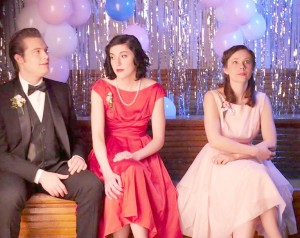
Rarely, Morgan said, is she able to get to the point where she is literally just living as if she is that character or is truly feeling those emotions. When it does happen, bonds are formed, not only with the other actor, but with the entire crew that is experiencing the power of that moment.
Jakob Reeder, a senior film studies major at MSUM and director of “Westall,” found that moment, shot in a forest that they had constructed in an abandoned bowling alley, to be one of the most rewarding of the entire shooting process.
“I really got a lot of stellar performances from the actors, which is personally really rewarding considering how much I’ve pushed them through. That day, I don’t think we wrapped until 8 or 8:30 in the morning, and we started shooting at 4 p.m. the day before, so to have people that dedicated is in and of itself is rewarding,” Reeder said.
Reeder described “Westall” as a sci-fi that is set in the 1950s, but has a modern aesthetic. It follows five high schoolers who, after one of their friends goes missing, try to find her and figure out what happened to her. At the same time, they are also navigating their own interpersonal relationships. The film is a senior seminar project that began in September and the crew just recently wrapped up the main shooting.
According to Reeder, as director, his job is to serve people as much as they are serving him as they do their job or perform and act. He works closely and sometimes one on one with the actors. Reeder is also responsible for approving the shot that the director of photography designs.
The director is the last step for everything. There are many people in charge of different departments, but they have to go to the director to get everything approved to ensure that everything is tying into the overall theme of the film, Reeder said.
According to Alicia Auch, a senior at Concordia who acted in “Westall,” directors offer good notes, but they have an entire vision that they are carrying out.
“So sometimes they are a little busy. Or they are dealing with a crisis or something has gone wrong. So many different variables come into play,” Auch said. “But there is always … sense of encouragement, support, and uplifting each other’s passions, so that in and of itself is really great.”
Beyond working with directors, actors must also develop a relationship with the character they are playing in order to portray them authentically and honestly, Morgan said.
“I love acting because you learn about who you are and you learn about others.” Morgan said. “I love stepping into someone else’s shoes and learning about them, but really, much of the time, at least for me personally, I’m bringing so much of myself to that role.”
Furthermore, film itself is a collaborative process according to Morgan. Writers, cinematographers, actors, and more are all brought into the mix, each with their own talents and expertise, and then everyone within that community works to create the film.
“There are times when getting to know your fellow actors is to your advantage so that chemistry can come across on screen. Other times — I had a big, emotional scene with the lead character and I really tried to avoid looking at him while we were in between takes,” Morgan said. “When I looked at him during the take, I wanted it to feel like it was the first time I was seeing him in that state.”
Bonds are also formed under the circumstances of shooting the film, where people are sometimes spending upwards of twelve hours together in a day. Shooting for “Westall” often began in the afternoon and continued into the wee hours of the morning. But long days and late nights are just one of the things that frequently comes with any low-budget film, small film or student film, Morgan said.
“You’re going to confront some of that stuff, but I think that it does bring an authenticity to the experience,” Morgan said. “There are challenges and things that are not ideal, but they add color to the experience. There is nothing I face that would make me feel like I would never do something like that again. Everything was worth it, because the experience was so powerful and so exciting.”
Reeder is beyond grateful for the dedication of his team on the film. Without them, “Westall” would not have become a reality.
“I would like to thank my core team. And of course, the cast and crew as well. Most of them drove out there, which is a 45-minute drive, on their own, fairly often. And pretty much every time, our shooting went way past what we told them it was going to and we all just stuck through it and stayed positive throughout the whole excursion,” Reeder said. “I can’t imagine having to dedicate that much time and sacrifice that much time and money. They really gave it their all; all of them did.”
To raise money for the film, Reeder and his crew ran a 60-day Indiegogo campaign. They shared their ideas for the film, including what they were doing and how they were doing it.
“We told people our passions and our dreams,” Reeder said, “and people seemed to be hyped on the project. It’s just unbelievable when you are really attached to something how many other people will come and hop on that ship with you.”
Crowdsourcing is just one way of connecting with people. For Reeder, that connection is what filmmaking is all about.
“Filmmaking is in the entertainment industry, but what it is all about is meeting new people and making all of these relationships,” Reeder said. “I know so many more people now because of ‘Westall’ and I’ve gained all of these relationships with these people that I feel like I can now reach out to them and ask them when I need something or talk to them about whatever. And that never would have happened if it wasn’t for ‘Westall.’”
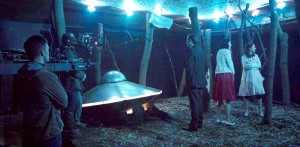
For example, Reeder drove out to Valley City, N.D. to get a television set from the 50s. The owners were an elderly couple, the parents of one of Reeder’s acquaintances, and Reeder spent some time just talking with them. They gave him the television for free, and it is kindness like that, Reeder said, that really makes working on a film worthwhile.
All in all, they raised $5,800, which was $800 over their goal for “Westall.” Part of this money went to creating sets. The film had four different sets between locations in Mayville and Portland, N.D. According to Reeder, the two small towns are like twin cities, a mere minute drive from one another, and about an hour from Moorhead.
All of the locations were found by Zach Wentz, the director of photography on the project, since Mayville is his home town, Reeder said. Locations include two rooms at a house owned by one of Wentz’s friends, a nearly abandoned school, and an abandoned bowling alley.
The bowling alley closed almost 10 years ago and has been stripped down past even the lanes. According to Rachel McCloud, a sophomore who acted in the film, the old abandoned bowling alley was super creepy. Beyond the constructed set, the only things that remained were dusty bottles and empty shelves.
“There was no heat, no plumbing. We didn’t have a bathroom, so if you really had to go, you just didn’t,” McCloud said. “Before we started, we took a trip over to the gas station that was down the road to use their bathroom.”
According to Auch, space heaters were provided. But the set Reeder and his crew had created was worth the shivering.
“It was amazing to me to walk up to the building that we were shooting in and then to walk inside of it, and witness the set that they had created,” Auch said. “You wouldn’t expect to walk into an old bowling alley and see a forest with a UFO. You just wouldn’t.”
Reeder and the rest of his crew began building the 24-by-24-foot forest back in November. According to Reeder, they bought large 8-by-4 plywood sheets from Home Depot and built frames with them, attaching legs to them as well so that they would be able to support the trees.
The trees and branches themselves were from Reeder’s parents’ farm. His parents have a trail that used to be an old railroad. It needs to be maintained to allow farming equipment to pass through, so the trees were already cut down. Many were already fallen or dead as well. Reeder and his crew only had to load them up and haul the thirty or so trees in a large trailer back to the set. It was a five-hour drive.
Then they measured each tree and cut holes in the plywood panels and ran a tree through. Finally, Reeder said, they brought in dirt and leaves that they had collected in autumn.
“So it’s real dirt, real leaves, real trees and fake forest. It’s pretty nuts,” Reeder said. “We also built a UFO, which was a crazy time.”
According to Reeder, casting for the film was also a crazy time and a difficult process. There were two open casting calls for “Westall,” but for the second, people whom Reeder was interested in having audition for parts were also contacted directly.
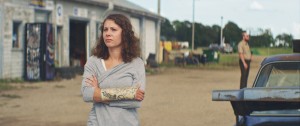
Morgan had worked with Reeder and Wentz over the summer in another film called “Supermoto,” which is a feature film commercially produced by Matthew Myers, husband to Jacqueline Bussie, associate professor of religion at Concordia and director of the forum on faith and life, Morgan said.
Most of the talent and crew in “Supermoto” were locals and many of them were from Concordia, including David Wintersteen, director of theater; Christian Boy, production designer; alums and many students — Alicia Auch, Michael Nunley, James Harvey — among others. Many people were also from MSUM and NDSU, Morgan said.
“What was really cool about that experience was being able to bring together students, alum and faculty, to work in a real, professional environment … on something completely unrelated to or outside of the academic world,” Morgan said.
For Morgan, the audition process for “Westall” was a lot of fun and very interesting since she was auditioning in front of people she knew and considered her friends and peers rather than the usual array of professors, strangers or people older than herself.
For Auch, “Westall” was her first experience with having an audition in front of a camera. For “Supermoto,” she had only submitted a video audition via an iPhone. However, being in the feature-length film eased her way into being able to do “Westall,” Auch said.
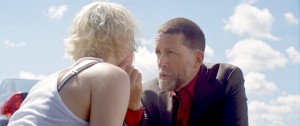
“[‘Supermoto’] was my first paid gig, so that was really cool that that was a possibility here in the area. I was a little nervous at first because I had never done a feature-length film … but it was a very open environment and I felt like I was allowed to ask questions with the professional team. I learned a lot,” Auch said. “That was really my first taste of it and once I got a taste of it, I wanted to do more.”
McCloud, too, auditioned for “Westall,” but did not get either of the two lead female roles, which went to Auch and Morgan. McCloud considers them both very talented actresses and was not upset at seeing the roles go to them.
McCloud then began working on a stage show doing technical work for the Fargo-Moorhead Community Theater when she got a call from Morgan.
“Hey,” Morgan had said to McCloud over the phone. “The script for ‘Westall’ has changed. We need a waitress for this small scene, and Jake, the director, wants you to do it. What are you doing? Are you in Fargo-Moorhead?”
It was the beginning of spring break, but McCloud was still in town. “Yeah, I have to … close the show that I’m working on.”
“Great! Do you want to come out to Mayville, N.D., and do some filming with us tonight?” Morgan asked.
“Fuck yeah, I do.” But McCloud’s hair was blue and the film was set in the 50s. She swore into the phone mic.
“That is not going to work,” Morgan said. “Would you dye it?”
“Hell yeah, I would dye it.”
McCloud then asked her mom to pick up some bleach and drop it off at her dorm.
“I bleached my hair, shoved a Subway sandwich in my mouth, got to the performance at the theater as fast as I could with bleached hair and did the show. Then we struck the set, and I got back and … picked up brunette dye and dyed my hair, and got immediately into my car and drove 45 minutes out to Mayville, N.D., to film a tiny little scene with two lines,” McCloud said. “It was totally worth it.”
According to McCloud, the students over at MSUM who are on the production team are really great and really professional. Morgan was also impressed by the level of professionalism that came out of the student-directed film.
“Even with the challenges that we faced, I had a blast and I would go back tomorrow and do it all over again,” Morgan said. “I think what is really special is the connections between MSUM and Concordia forming and I wish that we got to see more of that.”
Morgan wishes she had done more with the opportunity to engage and interact with students from other universities and colleges, because there is so much talent out there that students would never know about if they did not do a project together.
“As a Cobber, we share a lot of connections and shared experiences, and at MSUM, I go over there and things are dramatically different. We still share many experiences, but there is so much going on over there and that I never would have known or experienced without projects like these,” Morgan said. “So I think that that is really special, being about to form cross-university connections.”
“Westall” is currently in the editing process. Reeder plans to be done with editing by the end of March as the project is due mid-April. At that point, it will be turned in and shown to the class as well as being shown in the senior seminar exhibition at MSUM. Reeder also hopes to get the film into a few theaters as well.
“Supermoto,” the film that Reeder, Morgan, and Auch worked on this past summer, is set to have a cast and crew screening at the Fargo Film Festival on March 19. Morgan is currently promoting and publicizing for the event, along with preparing for the festival.
“You meet so many people at these festivals and things can spiral from there, so maybe I will walk away from the festival with a new opportunity. Or maybe I won’t, but I will walk away with all of these new connections and ideas.” Morgan said.
At some point, Morgan also hopes to send out a film that she directed last fall that was influenced by “Supermoto.” “The Road We Walk” stars Auch and McCloud, both of whom Morgan had worked with previously. The short film is about two women who go on a journey, Morgan said.
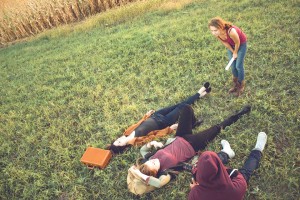
“The Road We Walk” was only Morgan’s second time directing film, and it was a passion project that she undertook as a learning experience. The day of shooting, she completely changed the script, but she still stands by it as the right choice.
The film was shot on back roads in south Moorhead, on dirt roads, in cornfields and on the prairie around the Bluestem area. According to McCloud, Morgan wasn’t entirely sure what she wanted from the script. Therefore, they filmed several different versions of every scene to give Morgan more options.
“There was a lot of times where we would be shooting shots [that come later in the film], so Alicia and I would be too clean,” McCloud said. “We would show up and be in our clothes and have showered recently, so we had to put product in our hair and literally roll around on the dirt road to get dustier. That was a weird experience.”
The transition into film was challenging for McCloud who had been doing theater for fifteen years. Acting in film is radically different than theater, McCloud said.
In theater, it is very much about performing in front of somebody who is twenty feet away, and performing in a style that is usually a lot more stylized, especially when the audience is straight on from what is happening. A lot of it is heightened from what natural existence looks like.
In a lab theater with an audience on three or four sides and five feet away instead of twenty or thirty, acting is less over-the-top and more realistic.
With film, it is so true to reality because the camera can be right there with you, McCloud said. There is no separation between the audience and the actor. Sometimes it is even less than reality. One must go for subtlety that doesn’t even exist in normal circumstance.
Being a theatrical person, transitioning to this subtlety was challenging for McCloud.
“I am quite loud and over-the-top and just a little bit obnoxious, and I’m okay with that. I like that as part of my personality. [But] with film, it is so much more subtle,” McCloud said. “A lot of the time, Amber would be like, ‘Calm your eyebrows,’ because my eyebrows just go crazy when I am talking.”
McCloud had to relearn how to act. Auch, too, had to make the transition, as she came from a theater background as well. According to Auch, the best way to learn and grow is through practice, which is why she jumped at the chance to be a part of “The Road We Walk.”
For both Auch and McCloud, the process of learning to act in film was made easier by the fact that they had worked together on previous projects and were good friends.
Now, having acted in both theater and film, one of the things Auch finds most interesting about stage acting versus film acting is where actors find their emotional build. While doing a theater show, everything is a one-time shot. It is live in action, and then one must move on to the next thing. The emotional arc can be and is rehearsed from beginning to end.
“Let’s say that in the beginning, I am very sad about something. By the end, I’ve resolved it. When I am doing that live in front of an audience, it is easy to understand and expect where I am going,” Auch said.
On a set, it is not as easy to have that emotion arc because there are cuts or there are issues that need to be fixed or something is wrong with the sound speed, so the scene has to be done again. Actors have to find that emotion time and time again, and be able to backtrack at a moment’s notice.
“Let’s say [you are in a scene] with your partner and it’s a breakup, and you have to find that sadness in you. You might get cut in the middle of it and then have to go all the way back to the beginning,” Auch said. “It’s making those parts of your emotion accessible over and over and over again, so that you can get the right shot.”
An upside to the cuts, Auch said, is that they allow actors to play with different styles of delivery. Each take can have a different rendition, can play with a different tone or emotion until a preferred version is found.
But sometimes there is only one chance to catch a shot. There was one scene in “The Road We Walk” where they were trying to catch the light in the last moments of the daytime hours because they were shooting outside. In the dying light, Auch was instructed to run into a soybean field to get an artistic shot of her trying to find somebody.
“I had never been in a soybean field before, and so I took my shoes off. I didn’t realize that soybean plants are very sharp, but we didn’t have any time left. The sun was setting. We had to get the shot,” Auch said. “So I ran out into the soybean field with bare feet. We got the shot and it was beautiful.”
When she got back to the car, her feet were all torn up and bloody, but it was worth it, Auch said, because they got the shot.
“I think that sums up a big lesson of what I’ve learned about filmmaking is that you have to take risks, and you have to be willing to play along, and be a team player,” Auch said. “I’ve gotten to do all of these projects by knowing a person who knows another person who knows another person in the area who is doing the same thing or who has the same passion.”
Really, Auch said, filmmaking is not about anyone as a personal actor. It is about the project as a whole and it is about collaboration.

